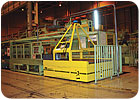Mitsubishi Motors North America (Cypress, CA) operates an assembly and stamping plant in Normal, IL, which operates two 8-hour shifts a day, 5 days a week, using more than 850 robots to build nearly 180,000 vehicles per year.

Mitsubishi Motors North America recently installed a laser-guided automated guided vehicle system to improve material handling at its plant in Normal, IL.
According to the plant’s staff engineer, Barry Hansis, the stamping facility is attached directly to the body assembly area. Fenders, roofs, doors and hoods are all produced on-site. Coiled steel is fed into a blanking press, which produces stacks of blanks that are then used to manufacture the actual parts. These blanks are stored in an automatic storage retrieval system (ASRS) until they are needed. Automated guided vehicles (AGVs) move the stacks from the ASRS system to various transfer presses.
“The shapes of the blanks vary from part to part. For example, a fender looks quite different from a quarter panel,” Hansis says. “The AGVs can handle stacks of blanks that weigh up to 6 metric tons. The maximum load size is 67 inches wide by 98 inches long by 14 inches high. The AGVs also interface with another 40 ton die handling AGV.”
Hansis notes there are many reasons for using AGVs: They save space, promote safety, cut labor costs and reduce the chance of error in material movement. However, the plant’s original AGV system was not especially efficient, and it became even less so with the passage of time.
“Our original wire-guided AGV system was built in Japan by the same company that designed our ASRS and crane system,” Hansis says. “The AGVs were controlled by a mainframe computer and were not very flexible. Plus, getting technical support from Japan was very difficult. We spent several years trying to maintain and improve the system performance with little success.”
To solve these problems, MMNA engineers implemented a new set of laser-guided Odyssey-model AGVs from AGV Products (Charlotte, NC). The result has been a system that is both efficient and easy to operate.
“Our primary goals when searching for a new AGV system were maintenance-free operation and a user-friendly control system,” Hansis says. “The new system’s host computer controls the AGVs, runs the cranes in the ASRS, controls inventory, schedules and controls deliveries, and routes the AGVs. The host computer is constantly looking for the most efficient way to route the AGVs. We can also connect with other computer systems throughout the plant.”
According to Hansis, vehicle path changes can now be made in a matter of minutes, and an automated charging system means operators are no longer continually changing out batteries. Each AGV comes equipped with an onboard laser, which sends out a light beam that is returned by reflectors permanently mounted around the shop, allowing it to keep track of its position.
“The path the AGVs take is fairly static. However, with the laser guided system it is very easy to change the path-just a click and drag operation on a PC,” Hansis says. “The entire system was installed and tested in less then a month and has been running almost trouble free ever since. The few problems that we have experienced were handled in a prompt and efficient manner.”
Odyssey vehicles are available in fork, unit-load and tow-style configurations. All standard Odyssey vehicles are equipped with an advanced safety system, which includes front, side and rear sensors, as well as a laser bumper detection system.
For more on AGVs, call 704-845-1110 or visitwww.agvp.com.